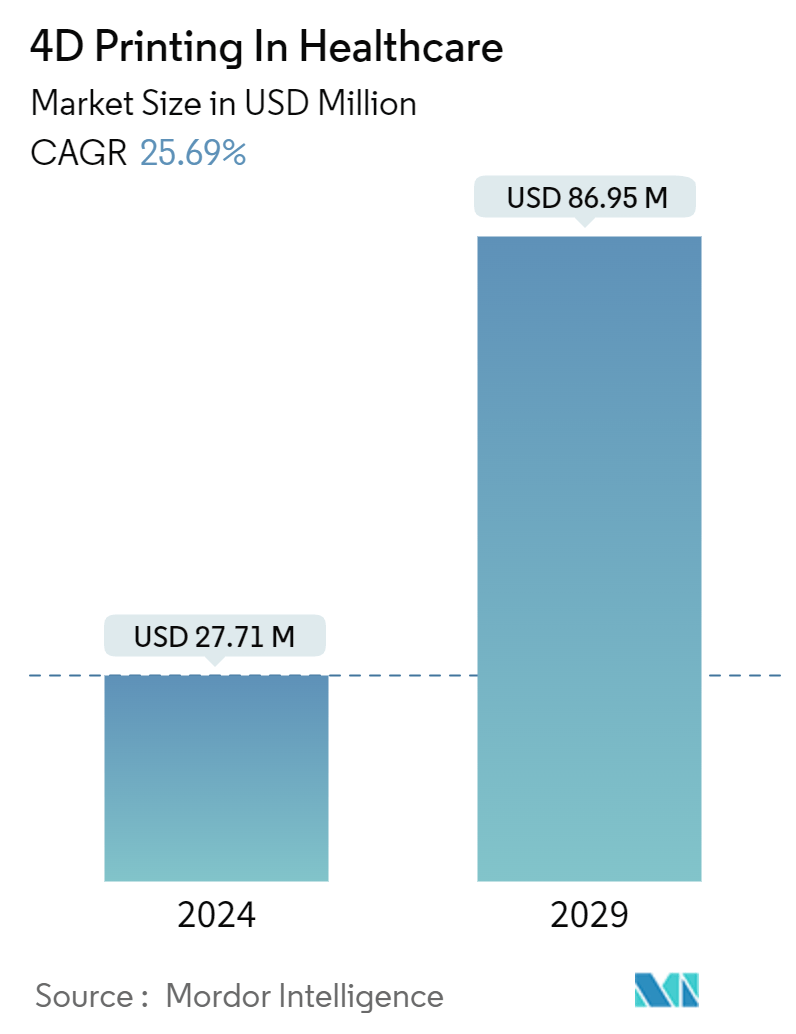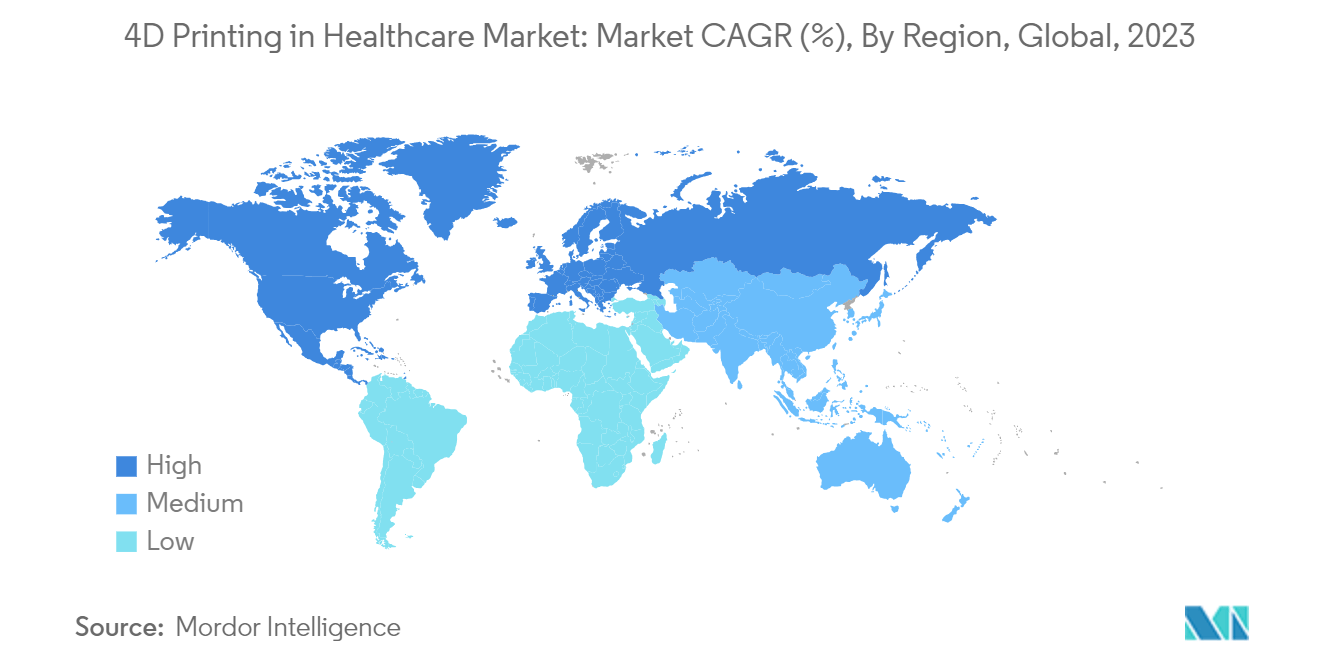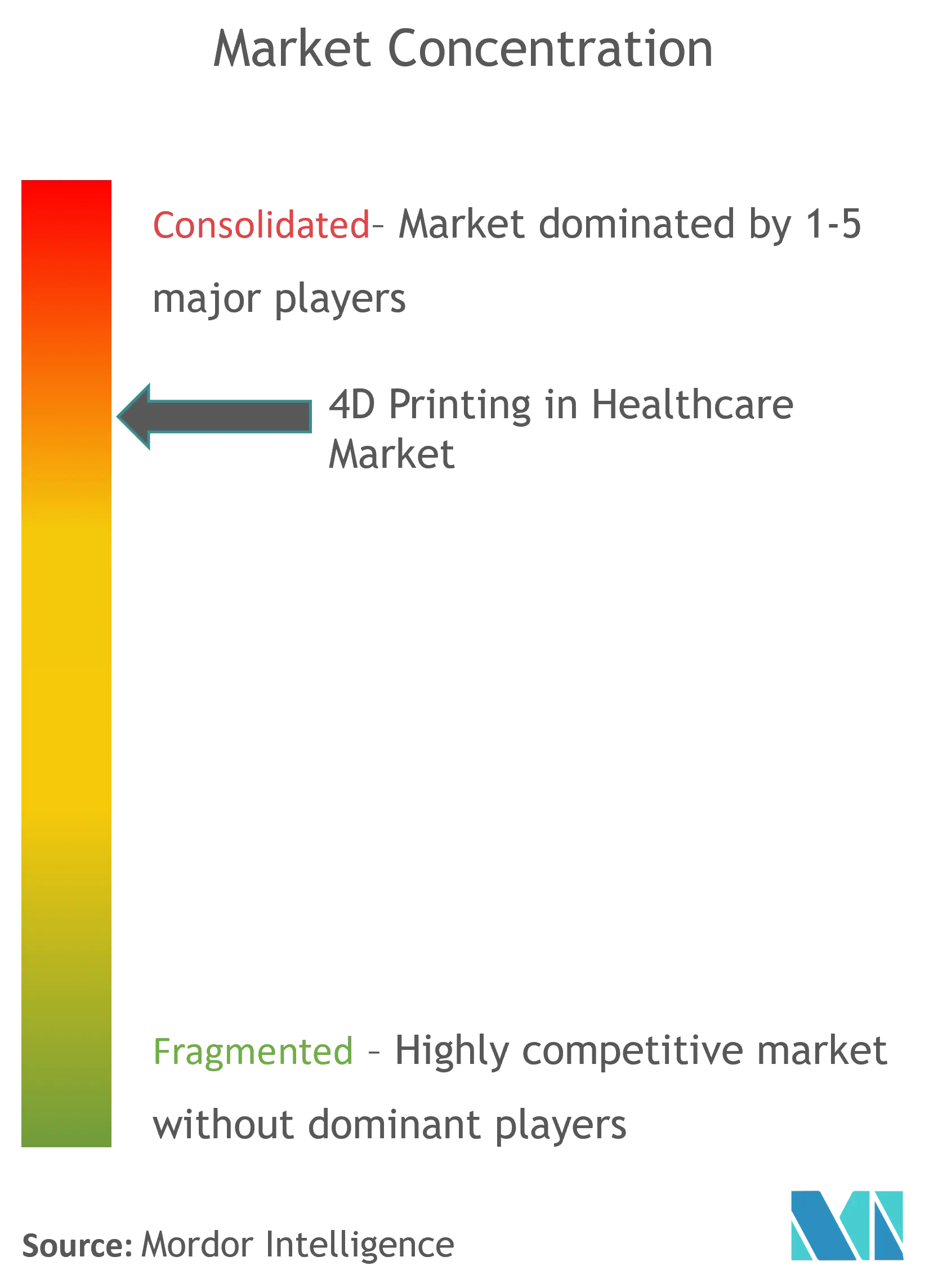4D Printing In Healthcare Market Size

| Study Period | 2019 - 2029 |
| Market Size (2024) | USD 27.71 Million |
| Market Size (2029) | USD 86.95 Million |
| CAGR (2024 - 2029) | 25.69 % |
| Fastest Growing Market | Asia Pacific |
| Largest Market | North America |
Major Players
*Disclaimer: Major Players sorted in no particular order |
4D Printing In Healthcare Market Analysis
The 4D Printing In Healthcare Market size is estimated at USD 27.71 million in 2024, and is expected to reach USD 86.95 million by 2029, growing at a CAGR of 25.69% during the forecast period (2024-2029).
Major factors driving the market include the rising demand for organ transplants, growing research and development activities, increasing user preferences to shift from 3D printing devices to 4D printing devices, and rising strategic activities such as new product launches by key players.
Organ or cell transplantation is a critical medical procedure that saves or extends the lives of thousands of patients suffering from organ failures. However, adequate organs are not always available for transplantation to meet the existing demand, and this is a major challenge in the medical field. 4D bio-printed organs can provide patients with safer and more effective transplants compared to 3D bio-printed organs. Hence, the increasing demand for organ transplantation is expected to drive the demand for 4D printing, driving the market over the forecast period.
According to an article published in the Columbia Undergraduate Science Journal in August 2023, around 100,000 people were on the national transplant waiting list in the United States in 2023. Hence, the increasing demand for organ transplantation is expected to increase the demand for 4D printing technologies, driving the market over the forecast period.
Increasing research and development activities in 4D bio-printing are also expected to create awareness about 4D technologies and increase their adoption. For instance, in August 2022, Poietis, a French start-up, developed the Next Generation Bioprinting (NGB) platform to achieve 4D bio-printing of biological tissue in a more affordable, faster, and more functional way. In 2022, the company also started the first clinical trial at the University Hospital AP-HM of Marseille, with the first skin graft of bio-printed tissue. Hence, such research and development activities are expected to increase awareness about 4D printing and drive the market over the forecast period.
Thus, the increasing demand for organ transplantations and growing research and development activities in 4D printing to generate tissues are expected to drive the market over the forecast period. However, the high cost of the development of 4D printing technology is expected to restrain market growth over the forecast period.
4D Printing In Healthcare Market Trends
The Tissue Engineering Segment is Expected to Hold a Significant Market Share Over the Forecast Period
Tissue engineering uses a combination of engineering, cells, materials methods, and appropriate physicochemical and biochemical factors to restore, maintain, improve, or replace different types of biological tissues. Tissue engineering is used to assemble functional constructs that restore, improve, or maintain damaged tissues or whole organs. Increasing investments in tissue engineering and rising strategic activities, such as the launch of new tissue-engineered products by key market players, are expected to drive the segment during the forecast period.
The increasing investments in tissue engineering drive the research activities for the development of 4D printing technologies to create constructs that transform into the desired structure upon implantation, facilitating better integration with the surrounding tissue and promoting cell growth and differentiation. Hence, the increasing investments in tissue engineering are expected to drive research activities in 4D printing and, thereby, the market over the forecast period.
For instance, in July 2024, 4D Medicine, a spin-out from the Universities of Birmingham and Warwick, raised EUR 3.4 million (USD 4.4 million) in a Series A investment. This funding will enable the company to complete pre-clinical testing of its first product range and seek clearance from the US FDA for entry into the US market. Its product, 4Degra, is a resorbable biomaterial that is being used to develop implants such as orthopedic devices or soft tissue scaffolds to help patients recover from surgery or injuries. Hence, such investments by tissue engineering companies are expected to drive the segment over the forecast period.
Furthermore, the various clinical applications offered by 4D printing in tissue engineering are also expected to increase its adoption. According to an article published in Advanced Materials in April 2024, 4D bio-printing has the potential to revolutionize tissue engineering by enabling the creation of functional tissues and organs. The technology's scalability ranges across various length scales. Hence, due to the various clinical advantages of 4D bio-printing, the segment is expected to witness growth over the forecast period.
Thus, the increasing investments in tissue engineering and various clinical advantages provided by 4D bio-printing in tissue engineering are expected to drive the segment over the forecast period.

North America is Expected to Hold a Significant Market Share Over the Forecast Period
North America's 4D printing market is expected to witness significant growth due to the presence of companies that manufacture 4D printing devices and software, increasing dental diseases in the region, growing organ transplantation, and increasing research activities in the development of 4D printing technologies.
The increasing organ transplantation in North America is raising the utilization of 4D printing to produce tissue that is able to transform its properties based on internal or external stimuli over time, similar to natural tissue. According to the Canadian Institute of Health Information January 2024 update, as of December 2023, a total of 3,427 Canadians were on wait lists to receive a transplant; 60% were active on wait lists, and 40% were on hold for a short period. Hence, the rising demand for organ transplantation accelerates research activities in 4D bioprinting, which is expected to drive the market over the forecast period.
Furthermore, the increasing investments in bioprinting increase the accessibility of 4D printing in healthcare. For instance, in July 2023, 3D BioFibR, a Canadian company, raised over USD 3.52 million to bring its bio-printed collagen fiber products to market. The funding will advance the company’s capabilities in manufacturing high-quality collagen fibers, highlighting the evolving landscape of bioprinting as it progresses from research to market-ready solutions. Hence, such investments are expected to increase the accessibility to 4D-printed biological products in the market, which is expected to drive the market over the forecast period.
Therefore, the increasing demand for organ transplantation and investments in bioprinting technologies are expected to drive the market in North America over the forecast period.

4D Printing In Healthcare Industry Overview
The 4D printing in the healthcare market is consolidated due to the presence of a few start-ups. The major players in the market are adopting various strategic activities such as mergers, collaborations, and expansions to strengthen their geographical presence and expand their customer base. Some of the key players in the market include Stratasys Ltd, 3D Systems Inc., Envision TEC, Poietis, and Organovo Holdings Inc.
4D Printing In Healthcare Market Leaders
-
Envision TEC
-
Stratasys Ltd
-
Poietis.
-
Rokit Healthcare
-
Merck KGaA
*Disclaimer: Major Players sorted in no particular order

4D Printing In Healthcare Market News
- July 2024: K Line Europe GmbH, a clear aligner manufacturer, launched ClearX aligners featuring a 4D printing technology in the United States. 4D-printed clear aligners combine 3D printing technology and shape memory materials. With this technology, aligner trays are printed using shape memory polymers (SMPs).
- July 2023: Researchers from Queen’s University Belfast created personalized 4D-printed “smart” implants for breast cancer management. These multipurpose implants change size to fit better within the breast cavity, resulting in personalization to an individual’s body. This helps improve aesthetic and confidence outcomes for those who have or have had breast cancer.
4D Printing In Healthcare Market Report - Table of Contents
1. INTRODUCTION
- 1.1 Study Assumptions and market definitions
- 1.2 Scope of the Study
2. RESEARCH METHODOLOGY
3. EXECUTIVE SUMMARY
4. MARKET DYNAMICS
- 4.1 Market Overview
-
4.2 Market Drivers
- 4.2.1 Rising Demand for Organ Transplants
- 4.2.2 Growing Research and Development Activities
-
4.3 Market Restraints
- 4.3.1 High Development Cost of 4D Printing Technology
-
4.4 Porter's Five Force Analysis
- 4.4.1 Threat of New Entrants
- 4.4.2 Bargaining Power of Buyers/Consumers
- 4.4.3 Bargaining Power of Suppliers
- 4.4.4 Threat of Substitute Products
- 4.4.5 Intensity of Competitive Rivalry
5. MARKET SEGMENTATION (Market Size by Value - USD)
-
5.1 By Technology
- 5.1.1 Stereolithography
- 5.1.2 Selective Laser Sintering (SLS)
- 5.1.3 PolyJet
- 5.1.4 Fusion Deposition Modelling (FDM)
-
5.2 By Application
- 5.2.1 Tissue Engineering
- 5.2.2 Drug Delivery
- 5.2.3 Patient Specific Implants
-
5.3 By Component
- 5.3.1 Software and Services
- 5.3.2 Equipment
- 5.3.3 Programmable Materials
-
5.4 By End User
- 5.4.1 Hospitals and Clinics
- 5.4.2 Research Institutes
- 5.4.3 Others
-
5.5 Geography
- 5.5.1 North America
- 5.5.1.1 United States
- 5.5.1.2 Canada
- 5.5.1.3 Mexico
- 5.5.2 Europe
- 5.5.2.1 Germany
- 5.5.2.2 United Kingdom
- 5.5.2.3 France
- 5.5.2.4 Italy
- 5.5.2.5 Spain
- 5.5.2.6 Rest of Europe
- 5.5.3 Asia-Pacific
- 5.5.3.1 China
- 5.5.3.2 Japan
- 5.5.3.3 India
- 5.5.3.4 Australia
- 5.5.3.5 South Korea
- 5.5.3.6 Rest of Asia-Pacific
- 5.5.4 Middle East and Africa
- 5.5.4.1 GCC
- 5.5.4.2 South Africa
- 5.5.4.3 Rest of Middle East and Africa
- 5.5.5 South America
- 5.5.5.1 Brazil
- 5.5.5.2 Argentina
- 5.5.5.3 Rest of South America
6. COMPETITIVE LANDSCAPE
-
6.1 Company Profiles
- 6.1.1 Stratasys Ltd
- 6.1.2 Merck KGaA
- 6.1.3 EnvisionTEC
- 6.1.4 Poietis.
- 6.1.5 Rokit Healthcare
- 6.1.6 Sculpteo
- 6.1.7 Self-Assembly Lab
- 6.1.8 Autodesk Inc.
- 6.1.9 Organovo Holdings Inc.
- 6.1.10 T&R Biofab
- 6.1.11 Alpha Additive LLC
- *List Not Exhaustive
7. MARKET OPPORTUNITIES AND FUTURE TRENDS
** Subject To Availablity4D Printing In Healthcare Industry Segmentation
4D printing in healthcare aims to construct complex forms that can transform their properties upon response to internal or external stimuli to repair, replace, or regrow diseased or damaged tissues, cells, and organs.
The market for 4D printing in healthcare is segmented by technology, application, component, end user, and geography. By technology, the market is segmented into stereolithography, selective laser sintering (SLS), polyjet, and fusion deposition modeling (FDM). The market is segmented into tissue engineering, drug delivery, and patient-specific implant by application. By component, the market is divided into software and services, equipment, and programmable material. By end user, the market is segmented into hospitals and clinics, research institutes, and others. By geography, the market is segmented into North America, Europe, Asia-Pacific, Middle East and Africa and South America. The report covers the estimated market sizes and trends for 17 countries across major regions globally. The report offers value (USD) for all the above segments.
| By Technology | Stereolithography | |
| Selective Laser Sintering (SLS) | ||
| PolyJet | ||
| Fusion Deposition Modelling (FDM) | ||
| By Application | Tissue Engineering | |
| Drug Delivery | ||
| Patient Specific Implants | ||
| By Component | Software and Services | |
| Equipment | ||
| Programmable Materials | ||
| By End User | Hospitals and Clinics | |
| Research Institutes | ||
| Others | ||
| Geography | North America | United States |
| Canada | ||
| Mexico | ||
| Geography | Europe | Germany |
| United Kingdom | ||
| France | ||
| Italy | ||
| Spain | ||
| Rest of Europe | ||
| Geography | Asia-Pacific | China |
| Japan | ||
| India | ||
| Australia | ||
| South Korea | ||
| Rest of Asia-Pacific | ||
| Geography | Middle East and Africa | GCC |
| South Africa | ||
| Rest of Middle East and Africa | ||
| Geography | South America | Brazil |
| Argentina | ||
| Rest of South America |
4D Printing In Healthcare Market Research FAQs
How big is the 4D Printing In Healthcare Market?
The 4D Printing In Healthcare Market size is expected to reach USD 27.71 million in 2024 and grow at a CAGR of 25.69% to reach USD 86.95 million by 2029.
What is the current 4D Printing In Healthcare Market size?
In 2024, the 4D Printing In Healthcare Market size is expected to reach USD 27.71 million.
Who are the key players in 4D Printing In Healthcare Market?
Envision TEC, Stratasys Ltd, Poietis., Rokit Healthcare and Merck KGaA are the major companies operating in the 4D Printing In Healthcare Market.
Which is the fastest growing region in 4D Printing In Healthcare Market?
Asia Pacific is estimated to grow at the highest CAGR over the forecast period (2024-2029).
Which region has the biggest share in 4D Printing In Healthcare Market?
In 2024, the North America accounts for the largest market share in 4D Printing In Healthcare Market.
What years does this 4D Printing In Healthcare Market cover, and what was the market size in 2023?
In 2023, the 4D Printing In Healthcare Market size was estimated at USD 20.59 million. The report covers the 4D Printing In Healthcare Market historical market size for years: 2019, 2020, 2021, 2022 and 2023. The report also forecasts the 4D Printing In Healthcare Market size for years: 2024, 2025, 2026, 2027, 2028 and 2029.
4D Printing In Healthcare Industry Report
Statistics for the 2024 4D Printing In Healthcare market share, size and revenue growth rate, created by Mordor Intelligence™ Industry Reports. 4D Printing In Healthcare analysis includes a market forecast outlook for 2024 to 2029 and historical overview. Get a sample of this industry analysis as a free report PDF download.



